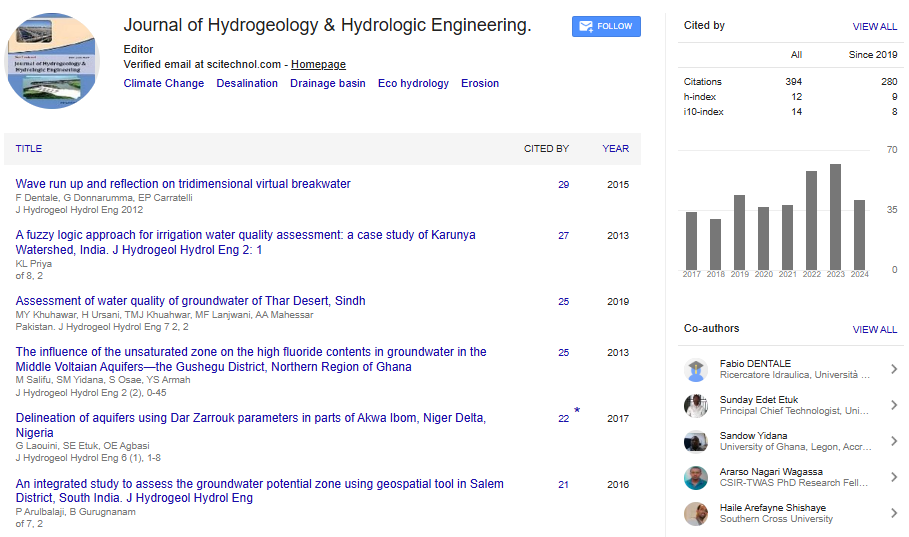Editorial, J Hydrogeol Hydrol Eng Vol: 9 Issue: 3
Study of the Waters Close to the Land Surface
David Steffy*
Department of Geology, Jacksonville State University, Alabama, USA
*Corresponding Author : David Steffy
Department of Geology, Jacksonville State University, Alabama, USA
Tel: +2567825966
E-mail: dsteffy@jsu.edu
Received: July 17, 2020 Accepted: July 31, 2020 Published: August 07, 2020
Citation: David S (2020) Study of the Waters Close to the Land Surface J Hydrogeol Hydrol Eng 9:3. doi: 10.37532/jhhe.2020.9(3).e102
Abstract
Hydrology manages that piece of the water cycle from the appearance of water at the land surface as precipitation to its inevitable misfortune from the land either by dissipation or transpiration back to the climate or by surface and subsurface stream to the ocean. It is hence fundamentally worried about waters near the land surface. It incorporates different segment orders of a progressively particular nature.
Keywords: Hydrogeology
Introduction
Hydrology manages that piece of the water cycle from the appearance of water at the land surface as precipitation to its inevitable misfortune from the land either by dissipation or transpiration back to the climate or by surface and subsurface stream to the ocean. It is hence fundamentally worried about waters near the land surface. It incorporates different segment orders of a progressively particular nature. Power through pressure is worried about the mechanics and elements of water in its fluid state. Hydrography is the portrayal and planning of the waterways of Earth's surface (counting the seas), with a specific worry for route outlines. Hydrometry includes estimations of surface water, especially precipitation and streamflow. Hydrometeorology centers around water in the lower limit layer of the environment. Groundwater hydrology and hydrogeology have to do with subsurface water in the soaked zone, while soil water material science includes the investigation of subsurface water in the unsaturated zone. Building hydrology is worried about the plan of man-made structures that control the stream and utilization of water. Fundamental all the hydrologic sciences is the idea of water balance, a declaration of the water cycle for a region of the land surface as far as preservation of mass. In a straightforward structure the water equalization might be communicated as
S = P − Q − E − G,
where S is the change of water storage in the area over a given time period, P is the precipitation input during that time period, Q is the stream discharge from the area, E is the total of evaporation and transpiration to the atmosphere from the area, and G is the subsurface outflow.
Precipitation
Precipitation results from the build-up of water from the climate as air is cooled to the dew point, the temperature at which the air gets soaked as for water fume. The cooling procedure is normally started by inspire of the air, which may result from various causes, including convection, orographic impacts over mountain reaches, or frontal impacts at the limits of air masses of various qualities. Build-up inside the air requires the nearness of build-up cores to start bead arrangement. A portion of the condensate might be conveyed significant separations as cloud before being discharged as downpour or day off, on the neighborhood temperatures. Some precipitation as dew or mist results from build-up at or close to the land surface. In certain zones, for example, the seaside northwest of the United States, dew and mist trickle can contribute essentially to the water balance. The arrangement of hail requires a grouping of build-up and freezing scenes, coming about because of progressive times of inspire. Hailstones for the most part show an example of concentric rings of ice subsequently.
Interception
At the point when precipitation arrives at the surface in vegetated territories, a specific level of it is held on or captured by the vegetation. Precipitation that isn't captured is alluded to as throughfall. Water that arrives at the ground by means of the trunks and stems of the vegetation is called stemflow. The capture stockpiling limits of the vegetation differ with the sort and structure of the vegetation and with meteorologic elements. Estimations have shown that up to eight millimeters of precipitation can be caught by some vegetation shelters.
Infiltration
At the point when water from a rainstorm or a time of snowmelt arrives at the ground, a few or every last bit of it will invade the dirt. The pace of penetration relies upon the power of the info, the underlying dampness state of the surface soil layer, and the pressure driven qualities of the dirt. Little scope impacts, for example, the nearness of a surface seal of low penetrability (because of the improvement of surface soil particles by downpour sprinkle) or the nearness of enormous directs and splits in the surface soil might be significant in controlling invasion rates.
Soil moisture
The dirt gives a significant repository to water inside a catchment. Soil dampness levels rise when there is adequate precipitation to surpass misfortunes to evapotranspiration and waste to streams and groundwater. They are drained throughout the late spring when evapotranspiration rates are high. Levels of soil dampness are significant for plant and yield development, soil disintegration, and slant dependability. The dampness status of the dirt is communicated regarding volumetric dampness content and the capability of the water held in the dirt pores. As the dirt gets wet, the water is held in bigger pores, and the slim likely increments.
 Spanish
Spanish  Chinese
Chinese  Russian
Russian  German
German  French
French  Japanese
Japanese  Portuguese
Portuguese  Hindi
Hindi 
